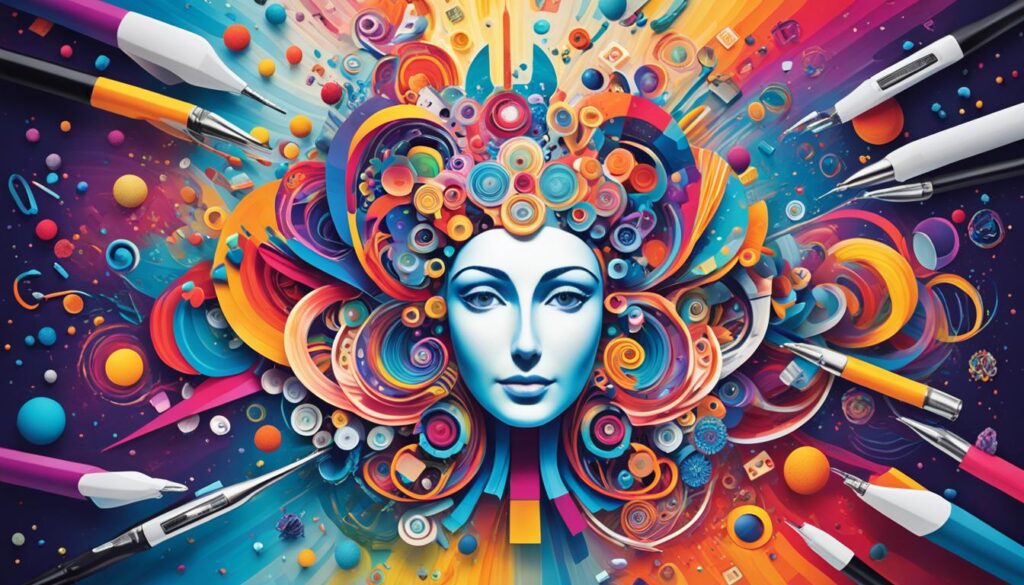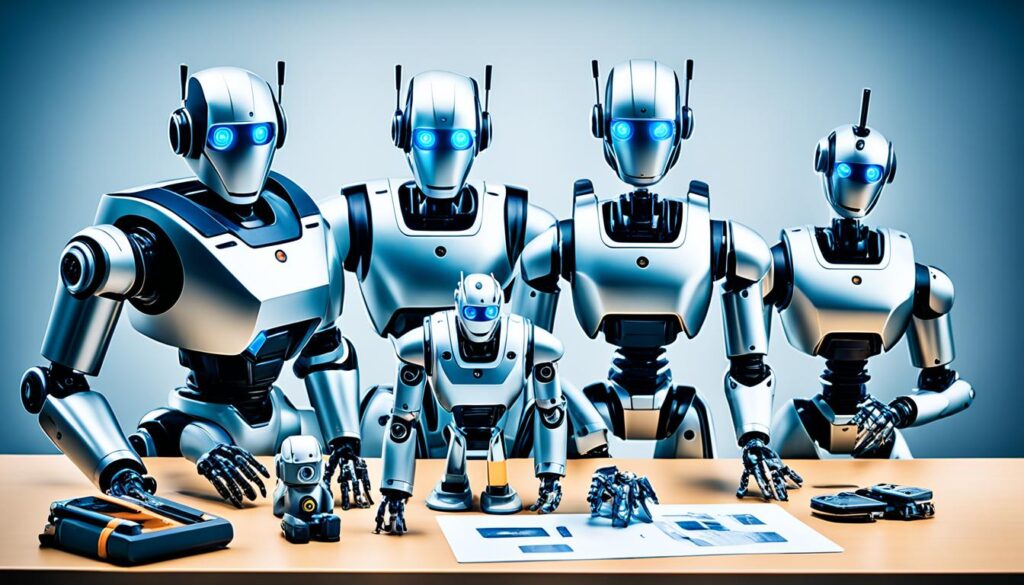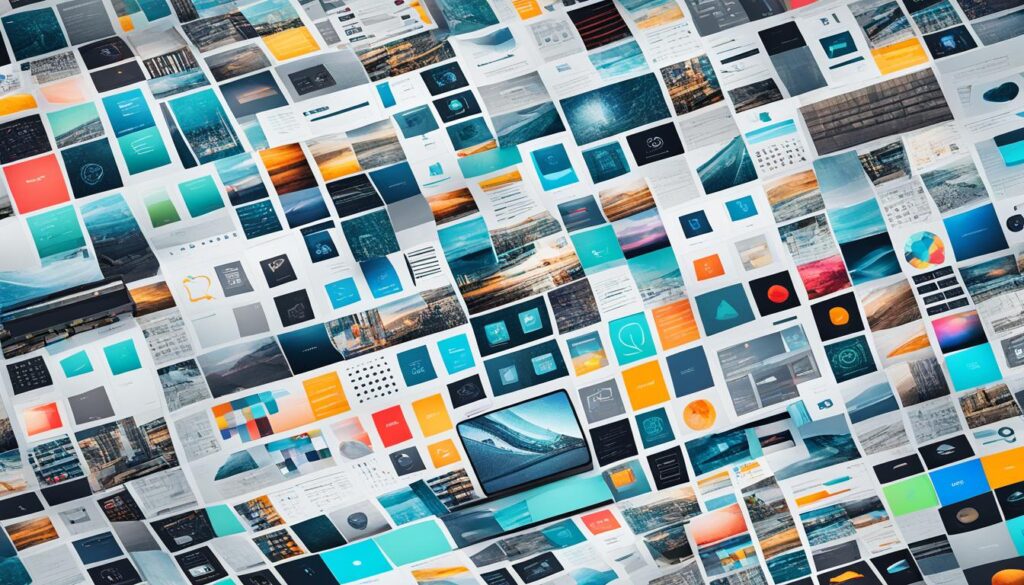In today’s digital world, making content that looks good is key for businesses and creators. Thanks to AI, making visual content is easier than ever. This guide will show you the AI tools that are changing how we make visuals. These tools let you create amazing visuals without much work.
Key Takeaways
- Discover the latest AI-powered tools that simplify visual content creation
- Learn how AI can unleash your creative potential and break down traditional barriers
- Explore the world of AI image generators and understand how they work
- Discover AI-powered design tools that enhance your visual storytelling
- Understand the applications of computer vision AI and its impact on visual understanding
- Explore the future of image synthesis with generative AI
- Understand the ethical considerations in using AI-generated visuals
Unleashing Your Creative Potential with AI
The use of creative ai software and ai-powered design tools has changed how we make visual content. Now, making art is open to more people. Thanks to AI, more folks can use visual communication to express themselves.
The Rise of AI in Visual Content Creation
AI has changed the game in creative work. It has made the process easier and available to more people. Image synthesis with ai lets anyone create beautiful content, opening new ways to tell stories and express themselves.
Breaking Down Traditional Barriers
AI has made creative tasks easier for those who wanted to make visual content. With creative ai software and ai-powered design tools, you can change, improve, and make visuals easily. This lets you turn your ideas into reality with more creativity and speed.
“AI has democratized visual content creation, empowering a new generation of creators to unlock their creative potential.”
The future of making visual content is with AI, and it’s very exciting. As image synthesis with ai gets better, the ways to tell stories and express yourself visually are endless.

AI Tools for Visual Content Creation
AI-powered tools have changed how we make visual content. They help both professional designers and individual creators. These tools open up new ways to tell stories through images.
Image generation software is a key tool in visual content creation. It turns your ideas into beautiful images. Tools like DALL-E, Midjourney, and Stable Diffusion let users create unique images with simple prompts.
- DALL-E: An AI model developed by OpenAI that can create digital images from natural language descriptions.
- Midjourney: A powerful AI-powered image generation tool that produces highly detailed and imaginative visuals.
- Stable Diffusion: An open-source AI image generation model that can create a wide range of images based on textual descriptions.
AI tools also help with photo editing, graphic design, video production, and 3D modeling. They use machine learning to automate tasks and make suggestions. This makes the creative process better.
“AI tools for visual content creation have empowered us to explore the boundaries of our creativity and bring our ideas to life in ways we never thought possible.”
The future of visual content creation looks bright with AI. We’ll see more automated image generation and smart design assistants. The future is definitely AI-powered.

Exploring the World of AI Image Generators
AI image generators have changed how we make visual content. They use advanced algorithms and neural networks to create unique images. This lets users tap into their creative side like never before.
How AI Image Generators Work
AI image generators combine machine learning, computer vision, and generative AI. They learn from huge datasets of images and their details. This training helps them make new images that look like the ones they’ve seen before.
Users give a text description or prompt, and the AI turns it into a beautiful image. This text-to-image process has made creative expression easier than ever.
Popular AI Image Generation Tools
The AI image generator world is always changing, with many platforms and tools available. Some top AI image generation tools include:
- DALL-E 2: OpenAI’s DALL-E 2 creates unique images from text, blending creativity with technology.
- Midjourney: This AI tool uses neural networks to turn text into stunning visuals.
- Stable Diffusion: An open-source AI model that lets users make high-quality images from text, offering flexibility and accessibility.
- Imagen: Google’s Imagen is a top text-to-image model, setting high standards for image quality and creativity.
These AI image generation tools are changing how we create visual content. They help individuals and businesses explore new creative possibilities and tell stories in new ways.
AI-Powered Design Tools for Visual Storytelling
The art of visual storytelling has changed a lot lately, thanks to ai-powered design tools. These tools help creatives make content that grabs attention and engages people deeply. We’ll look at how visual ai assistants and creative ai software are changing how we tell stories with pictures.
AI-powered design tools make coming up with ideas easier. They use machine learning to create many design ideas, from simple sketches to complete designs. This lets designers try out more ideas, making their work more unique and powerful.
These tools are also great at making designs come to life. They use computer vision AI to improve, refine, and perfect visual assets. You can change colors, add cool effects, and mix 3D elements easily. This helps creatives make their ideas look amazing and work efficiently.
“AI-powered design tools are transforming the way we approach visual storytelling, unlocking new levels of creativity and innovation.”
As making visual content gets more complex, AI-powered design tools are key to staying ahead. By using these tools, designers and visual pros can make stories that touch their audience and keep them engaged.
If you’re into design or making visual content, checking out ai-powered design tools can open new doors for you. With visual ai assistants and creative ai software, you can reach your full creative potential. You’ll be able to make content that wows and moves your audience.
Computer Vision AI: Enhancing Visual Understanding
Computer vision AI is changing how we make and use visual content. It lets us understand and create in new ways. This part of artificial intelligence is changing how we see, analyze, and use visual info. It’s opening up new ways to make visual content.
Applications of Computer Vision AI
Computer vision AI has many uses that are changing visual content creation. It helps with object recognition, image classification, and more. These tools are pushing the limits of what we can do.
- Object Detection and Recognition: AI can spot and find objects in images, helping with detailed analysis and tagging.
- Image Classification: AI sorts images into groups, helping with organizing and optimizing visual content.
- Facial Recognition: AI can recognize faces, making it easier to personalize and analyze emotions in images.
- Semantic Segmentation: AI breaks images into meaningful parts, helping us understand scenes better for creating content.
- Depth Estimation: AI creates 3D images from 2D ones, opening up new ways to make immersive and perspective-based content.
As computer vision AI grows, we’ll see more new uses. These will change how we make, view, and interact with visual content. Adding these AI tools to making visual content will bring new creativity and efficiency.
| Application | Description |
|---|---|
| Object Detection and Recognition | Identify and locate various objects within an image |
| Image Classification | Categorize images into distinct classes |
| Facial Recognition | Detect and recognize faces in visual content |
| Semantic Segmentation | Segment images into distinct semantic regions |
| Depth Estimation | Generate 3D representations from 2D images |
Creative AI Software for Visual Professionals
Visual professionals have seen a big change with AI in their work. We’ll show you some new creative ai software that helps designers, illustrators, and others make their work better. These tools make their jobs easier, let them try new things, and improve their work’s quality.
Adobe Sensei is a top tool in ai-powered design tools. It works with Adobe’s creative tools and uses AI to do boring tasks like color matching and making patterns. This lets creatives spend more time on the fun and important parts of their work.
Midjourney is another big deal in visual ai assistants. It lets users make beautiful images with just a few words. This tool uses AI to open up new ways to be creative. It helps visual pros try out new ideas in ways they couldn’t before.
| Tool | Key Features | Use Cases |
|---|---|---|
| Adobe Sensei |
|
|
| Midjourney |
|
|
These tools are just a few examples of how creative ai software is changing the game for visual pros. They use AI to help creatives do more, try new things, and make amazing work.
“AI-powered design tools are revolutionizing the way we create. They offer unprecedented levels of speed, accuracy, and creative freedom, enabling us to focus on the truly inspiring aspects of our work.”
We expect to see even more cool visual ai assistants as this field grows. These new tools will keep making visual pros’ work even better.
Generative AI: The Future of Image Synthesis
The world of making pictures is changing fast, thanks to generative AI. This new tech is changing how we make and use pictures. It’s making the line between real and imagined pictures fade away.
Advancements in Generative AI
Generative AI models like Variational Autoencoders (VAEs) and Generative Adversarial Networks (GANs) have improved a lot. They can now make pictures that look real, unique, and can be changed to fit what we want. These models learn from pictures to make new ones that look like real things or art.
New tech in generative ai for visuals is opening up new possibilities. Now, AI can make clear images from just words, making it easy to turn ideas into pictures. This change is big for many fields, from ads to movies.
| Feature | Benefit |
|---|---|
| Photorealistic Image Generation | Can make pictures that look real and fit right into different places. |
| Customizable Image Synthesis | Users can make their own unique pictures with text prompts or model settings. |
| Rapid Prototyping | Generative AI lets us quickly try out ideas and see how they look. |
As generative ai for visuals keeps getting better, the future looks exciting. These new technologies will change how we make and use pictures. It will bring a new era of endless creativity and new ideas.
Ethical Considerations in AI-Generated Visuals
The use of ai tools for visual content creation is growing fast. We need to think about the ethical sides of this. We should look at the challenges and worries about AI-generated visuals, like authenticity, bias, and responsible use.
One big worry is AI visuals could spread false info or deceive people. With generative ai for visuals, it’s hard to tell real images from AI-made ones. This makes us question the trustworthiness of visual content and the need for clear labels.
Also, computer vision ai might carry biases from the data it learned from. This could mean visuals that show harmful stereotypes or leave out some groups. It’s important to fix these biases so AI visuals show everyone’s stories.
As AI in making visuals gets more common, we must think about its ethical use. This means setting rules to stop AI visuals from being misused. It also means making sure users know the limits and risks of using them.
“The responsible development and use of AI-generated visuals is not just a technical challenge, but a moral imperative.”
By tackling these ethical issues, we can use AI for making visuals in a good way. We need to keep our visuals true, real, and for everyone. As we move forward, staying alert and setting the right ethical rules is key for AI-powered visual content.
Integrating AI into Your Visual Content Workflow
Adding AI tools to your visual content creation can change the game. With the latest AI tech, you can make your work faster, more creative, and visually stunning. This helps grab your audience’s attention.
Best Practices for Using AI Tools
To make the most of AI in visual content creation, follow these tips. First, learn what each AI tool can and cannot do. This sets your expectations right and helps you use its features well. Second, keep trying out different AI tools and methods to see what suits you best.
Also, remember to keep a human touch in your work. AI can help, but it shouldn’t replace your creative vision. Mix AI’s power with your skills to create visuals that are both cutting-edge and uniquely yours.
